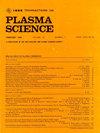A Single-Driver Marx Generator Based on Series-Connected Switches With High Synchronization
IF 1.3
4区 物理与天体物理
Q3 PHYSICS, FLUIDS & PLASMAS
引用次数: 0
Abstract
As the applications of pulse generators continue to develop in a variety of fields, so do the requirements for pulse generators. The development of pulse generators is facing many key issues, such as high-voltage drive isolation, compact design, and weight reduction. In this regard, a single-driver Marx generator (SDMG) based on series-connected switches (SCSs) is proposed in this article. The proposed SCS module improves the voltage withstand capability of each Marx stage while ensuring good synchronization of the switches, thus reducing the number of Marx stages. Moreover, in the whole Marx generator, only one switch needs to be triggered by the driver; the rest of the switches can be self-triggered by coupling capacitors. With the reduction in the drivers and Marx stages, the size and the cost of Marx circuits are significantly reduced. The working principle is first analyzed. Then, through the simulation, the proposed SCS module is verified to have a higher switching synchronization compared to the related topologies previously proposed. Finally, an SDMG prototype based on the SCS is developed. The output parameters of the SDMG are tested. The test result shows that the SDMG can output pulse with a voltage of 12 kV and a rise time of 69.5 ns. The pulsewidth can be flexibly adjusted from 200 to 1000 ns, and the size of the generator is very small, only基于高同步串联开关的单驱动器马克思发生器
随着脉冲发生器在各个领域的应用不断发展,对脉冲发生器的要求也在不断提高。脉冲发生器的发展面临着高压驱动隔离、紧凑设计和轻量化等关键问题。为此,本文提出了一种基于串联开关(scs)的单驱动器马克思发生器(SDMG)。提出的SCS模块提高了每个马克思级的耐压能力,同时保证了开关的良好同步,从而减少了马克思级的数量。而且,在整个马克思发电机中,驱动器只需要触发一个开关;其余的开关可以通过耦合电容器自触发。随着驱动器和马克思阶段的减少,马克思电路的尺寸和成本显着减少。首先分析了其工作原理。然后,通过仿真验证了所提出的SCS模块与之前提出的相关拓扑相比具有更高的切换同步性。最后,开发了基于SCS的SDMG原型机。测试了SDMG的输出参数。试验结果表明,SDMG可输出电压为12 kV、上升时间为69.5 ns的脉冲。脉冲宽度可在200 ~ 1000ns之间灵活调节,而且发生器的尺寸非常小,仅为13 × 6 × 2.5 × cm。
本文章由计算机程序翻译,如有差异,请以英文原文为准。
求助全文
约1分钟内获得全文
求助全文
来源期刊

IEEE Transactions on Plasma Science
物理-物理:流体与等离子体
CiteScore
3.00
自引率
20.00%
发文量
538
审稿时长
3.8 months
期刊介绍:
The scope covers all aspects of the theory and application of plasma science. It includes the following areas: magnetohydrodynamics; thermionics and plasma diodes; basic plasma phenomena; gaseous electronics; microwave/plasma interaction; electron, ion, and plasma sources; space plasmas; intense electron and ion beams; laser-plasma interactions; plasma diagnostics; plasma chemistry and processing; solid-state plasmas; plasma heating; plasma for controlled fusion research; high energy density plasmas; industrial/commercial applications of plasma physics; plasma waves and instabilities; and high power microwave and submillimeter wave generation.
 求助内容:
求助内容: 应助结果提醒方式:
应助结果提醒方式:


